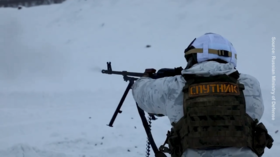WATCH: Russian snipers stage camouflage drills in snowy Far East
Russian snipers have disguised themselves in camouflage to blend in with the snow and practiced taking out enemy assailants in extremely low temperatures and frosty conditions in the Far East.
The country’s Ministry of Defense said on Thursday that marksmen from the Eastern Military District set up concealed vantage points and so-called “lie-ins” while conducting exercises at the Bikinsky range in Khabarovsk, over 6000 kilometers (more than 3700 miles) from Moscow.
According to military chiefs, the snipers were ordered to become invisible to nearby observers, undetectable even by those standing as close as five meters away.
During the tactical and special training, the marksmen honed their skills in finding targets and identifying major threats. They were required to eliminate a group of enemy saboteurs and transmit the coordinates of light armored vehicles, which soldiers practiced destroying using large-caliber 12.7 millimeter ASVK rifles.
The exercises come among a string of measures aimed at strengthening Russia’s ability to fight in the Arctic region. Last month, marines from the country’s Northern Fleet held tactical drills in the village of Sputnik in the Far North region of Murmansk. During the training, soldiers fired rounds at distances ranging from 10 to 300 meters.
In January, the Ministry of Defense said army snipers in the Far East region of Transbaikal, almost 2,000km away from Bikinsky, staged wargames in which soldiers shot mocked-up enemies at ranges of up to 1,000 meters in temperatures of -35 degrees Celsius (-31 Fahrenheit) throughout the day and night.
Russia has set its sights on maximizing new channels for shipping as Arctic sea ice melts away year by year, announcing a target for at least 80 million tons of goods to flow through the waters by 2024. However, the US previously hinted it could kick-start ‘freedom of navigation’ patrols to challenge Moscow’s dominance. At the beginning of the year, then-US Secretary of the Navy Kenneth Braithwaite said, “You will see the Navy operating again in a more permanent manner above the Arctic Circle,” adding that Washington will “operate more assertively” to counter the growing Russian presence in the region.
In December last year, a specialist research facility was reopened near the Russian capital to test the ability of weaponry to withstand grueling weather conditions and temperatures as low as -60 degrees Celsius (-76 Fahrenheit).














